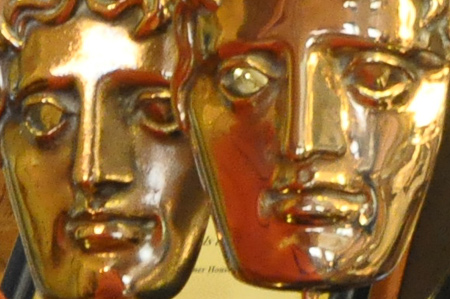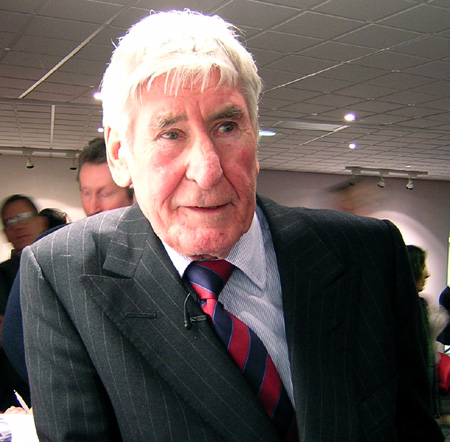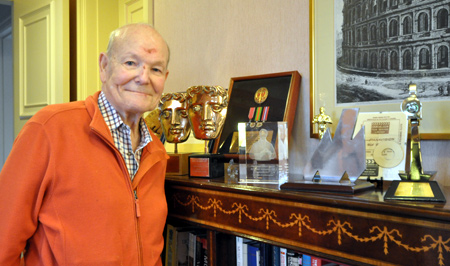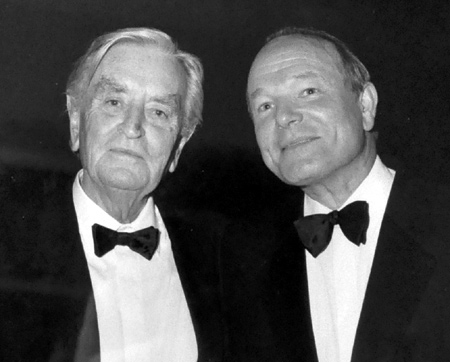Sir Sydney Samuelson and Real Picture Quality | Read more at in70mm.com The 70mm Newsletter |
| Interviewed by: Thomas Hauerslev. Transcribed for in70mm.com by Brian Guckian. Proofread by Sir Sydney Samuelson and Mark Lyndon for accuracy. Images by Thomas Hauerslev, unless otherwise noted | Date: 26.08.2013 |
David Lean and The Friese-Greene Award | |
 BAFTA
awards BAFTA
awardsAsk me another question that’s important to you – TH: I think we should talk about David Lean because you knew him well, and he shot "Ryan’s Daughter" on 65mm and "Zhivago" on 35mm (then printed up to 65mm) – both with Freddie Young as DP. Sir Sydney: Yes, we can talk about that, and I can get the photograph I’ve got of me with him. You can reproduce it if you want to! [Break] [Upstairs] Sir Sydney: Now look at this please. TH: The Friese-Greene Award... Sir Sydney: Do you know who Friese-Greene was? TH: He made projectors, I seem to remember – |
CHAPTERS • Home: A Conversation with Sir Sydney Samuelson • Cinema was always in my Family • Panavision, Bob Gottschalk and The Answering Machine • Stanley Kubrick, "Tom Jones" and one point • Dickie Dickenson, David Lean and British Quota Film • Stanley, Joe and "2001: A Space Odyssey" • Takuo Miyagishima, Robert Gottschalk and a 20:1 Zoom • Thunderball, Zhivago, Techniscope, and Fogging a roll of film • Ken Annakin, "Grand Prix", James Bond, Helicopters • How lucky can you be More in 70mm reading: • The Importance of Panavision • A Message from Freddie A. Young • Stanley Kubrick • Shooting "Lawrence of Arabia" • Memories of Ryan's Daughter • Joe Dunton • Ken Annakin • 70mm in London 1958 - 2012 • The editor Receives BKSTS award |
 Alex
Thomson in Bradford, 22. March 2004 Alex
Thomson in Bradford, 22. March 2004Sir Sydney: – Cameras; certainly the first British moving image camera was allegedly invented by Claude Friese-Greene. My brother David, who knows more about the detail and the history, says the trouble with the Friese-Greene camera was, it didn’t work very well! Friese-Greene actually died in abject poverty...he dropped dead at a technical meeting and he was found with only a few coppers in his pocket – but he had an achievement that was a start to Cinematography in this country. His son became a very fine Cinematographer. Ronnie Neame was his operator – and he, Ronnie, got his first breaks as a Lighting Cameraman when deputising for Friese-Greene. His great grandson, I think it is, was the young man (who works for Panavision Ireland, in their branch there) who presented the Friese-Greene Award to me. And I knew nothing about it until it happened. It’s a beautiful glass thing – not easy to lift it – it was designed by a Cameraman’s wife, Alex Thomson – the late Alex Thomson BSC – you’ve heard of him? TH: I met him – Sir Sydney: Oh, you met him – TH: - in Bradford – he came up and presented "Hamlet", which he shot for Kenneth Branagh in 65mm. Sir Sydney: Absolutely – his wife is a fine sculptress, and she designed it – I think the BSC commissioned it – the Friese-Greene – is a life-size statue in the house at the front of Shepperton Studios, and then I think the BSC must have commissioned her to make some miniature versions. [Shows statuette] I did it small because I wanted to keep it – can you read that? TH: “Presented to Sir Sydney Samuelson CBE by William Friese-Greene’s great-grandson Kevin Greene at the All-Industry Tribute Lunch (to Sydney) at the Grand Camelot Room, London 22nd September 2011. The Award was created to honour the man who is regarded as the inventor of Kinematography. It was his death in poverty in 1921 that led to the founding of the Cinema Veterans, now the British Cinema and Television Veterans and also the Cinema and Television Benevolent Fund. The Cinema and Television Benevolent Fund has become the Custodian of the Friese-Greene Award. It is intended to recognise people with an outstanding career in Cinema, or who have made a major contribution to the Cinema and Television industries. The Fund believes there can be no more suitable recipient for this first Award than Sir Sydney Samuelson CBE for his lifetime achievements” Nice! |
Internet link: • George Berthold "Bertie" Samuelson (1889 - 1947) (PDF) • Samuelson Film Service (reunion) • samuelson.la • The Argus • British Film Industry Salute • Wikipedia YouTube/Vimeo • 'Strictly Sydney' • Clapper Board Part 1 • Clapper Board Part 2 • St. Mary's 1963 |
 Sir
Sydney Samuelson with his awards. Sir
Sydney Samuelson with his awards.Sir Sydney: The first time it’s been presented – so there’s a bit of history about the British industry. Right, I’ll just get the David Lean photo – TH: Would you mind if I took a picture of you next to your awards up here? Sir Sydney: No, I wouldn’t mind at all – and in fact, if you’re not going to show it – the lower part, I could kneel down there so I’d be level with it! [Laughter] TH: I’ll bring the camera! [Takes photo] TH: It’s wonderful pictures you have – like these portraits – really nice. Sir Sydney: That one’s a French – the painter was French – they are, I think, of a Sicilian couple – When we moved to – first time we had quite a large house, we needed stuff to hang on our walls. We knew the kind of things we liked, so we spent a couple of years collecting pictures. What amazed us, Tom, was how many pictures that we absolutely would be aghast if they were hanging on our wall! Like hunting scenes, where someone’s holding up the fox, with its throat cut, with the dogs yapping, who would want that on their wall? And the other subject that there are a lot of, is a Biblical theme – John the Baptist with his severed head on a silver slaver, sometimes with the blood dripping down the side! | |
 Sir
Sydney Samuelson with his picture of Sir David Lean and himself. Sir
Sydney Samuelson with his picture of Sir David Lean and himself.– Here’s the David Lean – [TH takes photo] TH: David Lean’s films: I think "Doctor Zhivago" is one of my all-time favourite movies...I read Kevin Brownlow’s magnificent book about David Lean, and I’ve been following David Lean since the mid ‘70s when I saw "Doctor Zhivago" and "Lawrence of Arabia" for the first time. So can we talk about David Lean? – Sir Sydney: OK – David Lean, in my book, is, as far as Cinema is concerned, the greatest story-teller in cinema history. When you think of just the stories – of course the fact that most of them are big stories – but when you think of what is in a traditional David Lean film, it’s so impressive. That doesn’t mean he’s the only British filmmaker that matters, but, as far as the screen is concerned – the action and romance – and the relationship that he depicts one human being has for another, and the complexities of the way people think, from so many different backgrounds. David Lean I first came to know really through Panavision. It was at the time of "Lawrence of Arabia" but it was not when I personally began to know David. What I only learned later was that the great Freddie Young – now I don’t need to explain to you Tom, who Freddie Young was – or the significance of it being him I’m going to talk about – but he had just won what I think was Panavision’s first Oscar: first Oscar for Best Cinematography of a film shot in Panavision – "Lawrence of Arabia" – Panavision 65. Bob Gottschalk was ecstatic – I think because he had so many people in LA, his own town, who didn’t like him. He would have felt that they were his enemies, you could be a Bob Gottschalk enemy simply because you didn’t use Panavision! There wasn’t anything in between, there was jealousy I think in the other direction towards Bob, because he had produced something really superior – lenses, anamorphic lenses that were better than any anamorphic lenses in existence before he came on the Hollywood production scene; he had great success as a company who’d come from nowhere. Bob originally owned a camera shop, I know I talked about this to you already. What happened was that various firms in Europe had approached Bob Gottschalk and said, “Well, your anamorphic lenses seem to be very well thought of in America, so why don’t you have representation outside America, especially in Europe?” Now I don’t know who else approached him, Bob, except for one. Remember, first of all, in Bob Gottschalk’s eyes, Freddie Young could do no wrong, and they had become very good friends. So, when Freddie was doing another picture, it was automatically planned to be in Panavision. Freddie would go over to Los Angeles to talk about the equipment and he would spend time there. Bob Gottschalk would entertain Freddie and his wife, Joan, constantly. If they would agree, he would take them out every night and drive them out somewhere interesting in the Los Angeles area. At the weekend nothing changed as far as entertaining the Youngs was concerned. Freddie had asked Bob about his business and how it was that he had got equipment that people really wanted, especially the lenses. It was mostly to do with anamorphic lenses at that time – there was no 35mm Panavision camera, for example, until later. But people wanted to rent anamorphics which could be shipped as necessary, and fitted to their own Mitchell camera. The only exception was Panavision supplied, for hand-holdable shooting, an Arriflex camera body adapted to take Panavision lenses. It was not monobloc lenses, meaning an anamorphic lens which was the prime lens and the anamorphoser all in one piece – it was the attachment anamorphoser that was in front of the prime lens. It meant, in those days, that you had to have two focus pullers, because if you needed a shot where focus had to be changed during the shot, you had to have one focus puller for each lens - because the focus scales were separate, and the amount of movement to go, say, from 20 feet to 4 feet, the amount of movement to change the focus on the anamorphoser was different to how much change there was on the prime lens. Sometimes the control lever for the change of focus was on the opposite side of the camera for the anamorphoser, compared to the focus lever for the prime lens. But nevertheless, Panavision would supply a hand-holdable camera, an Arriflex, that would take three prime lenses on its turret, with an anamorphoser that you can put in front of any one of the three. And that was pretty well all that Panavision supplied in those days. Now when Freddie was next over in Los Angeles, checking out the equipment he would need for his next picture, which was also Panavision - but Panavision 65 – it was called "Lord Jim" – I think that was the picture he did next, after "Lawrence" – TH: Freddie went to Los Angeles again? | |
 Sir
David Lean and Sir Sydney Samuelson. Sir Sydney's collection Sir
David Lean and Sir Sydney Samuelson. Sir Sydney's collectionSir Sydney: ...Freddie went to Los Angeles, but the person who really needed to go to check out the gear was not Freddie, not Freddie’s operator, rather it was Freddie’s focus puller! He was the chap who would be in charge of all the equipment on the shoot, and he was the chap who knew best about all the equipment. He was the chap who would say, “I’d also like to look at the matte boxes” and if he was shown a matte box that would only take one filter, he would be the one who would say to whoever was showing him the equipment at Panavision, “Yes, but Mr. Young sometimes wants to put a diffuser on, as well as an 85 filter – you need a matte box that will take two filters...or he might want to be able to take a fog filter, as well as another filter”. And so Panavision would, without too much difficulty, make matte boxes for this particular job that would each have two filter holders built into them, and maybe even a rotating third filter holder to put a Polascreen into. And so the focus puller was the key man. But of course Freddie was the one who would go for two weeks to Panavision to be shown around town with his wife, by Bob Gottschalk, and who would be looked after by Bob’s people. Everybody would have a lovely time. And being Oscar-winning Freddie Young, for the Distributor making – financing – the next picture – if Freddie said, “I think I need to go to Los Angeles to talk about the equipment I want – to see what they’ve got that’s new would be useful” – they wouldn’t say, “No, we can’t afford that Mr. Young” – he would be allowed to go. A lesser-achieving Cameraman would be told, “I’m afraid you’ll have to do it on the phone”! Anyway, Bob Gottschalk had lots of hours of conversation, and I know at some time Freddie must have been talking about representation of Panavision in the UK...and Bob must have said, “Well I’ve had somebody, who seems to have the necessary facilities and the necessary company set-up, that they could represent us in London – which is the first place we would probably want to have an agency. A man came to see me, John Davis – in fact, Sir John Davis – and he runs The Rank Organisation. And The Rank Organisation already represents camera companies like Nikon – they distribute Nikon in the UK – and Pentax, and he said that his firm would definitely be right to distribute Panavision”. Freddie said something about, “I think, before you sign up with The Rank Organisation, I doubt if John Davis himself would know what your technical requirements would be; first of all, The Rank Organisation knows nothing about renting equipment, they only know about selling equipment. Yes, they sell Arriflex cameras – they’re the agents - they sell Nikons and Pentaxes, and all sorts of hi-fi equipment – but they don’t know anything about renting equipment. So I think you should see Sydney Samuelson”. Now in parallel to that – and I’ve also already told you about this – I realised that more and more credits on films I saw had a logo which said, “Photographed in Panavision” - less and less seemed to be “CinemaScope”. Of course there was a bit of Todd-AO 65mm at that time – "Around the World in 80 Days", for example. So Bob Gottschalk had obviously taken on board that there was a chap recommended by, in his mind, Freddie Young – he who could do no wrong – “He Who Shall Be Obeyed” if you like, to use another phrase. “He’s told me about four brothers who do know about equipment, and Cinematography, and they have a rental company”. But he didn’t do anything about it, because taking decisions as momentous, for Bob Gottschalk, as somebody else handling his beloved equipment, would take a bit of thinking about; a bit of investigation. Purely by coincidence, I was attempting to get in touch with him. I used to try on the telephone, but I don’t think I was ever put through to him – “I will tell Mr. Gottschalk, Mr. Samuelson, that you called again, and I’ll ask him if he would be able to call you back”. It never got any further than that. And then I used to start enlarging on the content of my phone calls by saying, “A long-time customer is preparing a major feature film, and I’m pretty certain that they would shoot in Panavision anamorphic if they could come along to us to get Panavision anamorphic lenses”. I would have conversations – not with Bob Gottschalk, but with his Number Two – a chap called Frank Vogelsang – but it never got to the Boss Man...or it got to the Boss Man, but he never responded directly to me. And then I noticed, of course, that with individual production companies, some of them were determined to use Panavision, and were renting Panavision lenses themselves from Panavision, Los Angeles – renting them – because Panavision didn’t sell anything – they were renting themselves, bringing them in, setting up the lenses on the cameras they were going to use – from Shepperton or Pinewood Studios. Mind you, they had to cut a set of matching viewfinder cams for their own cameras, a long and tedious procedure. | |
|
• Go to next chapter:
Thunderball,
Zhivago, Techniscope, and Fogging a roll of film • Go to previous chapter: Takuo Miyagishima, Robert Gottschalk and a 20:1 Zoom • Go to full text: Sir Sydney Samuelson and Real Picture Quality • Go to home page: A Conversation with Sir Sydney Samuelson | |
| Go: back - top - back issues - news index Updated 22-01-25 |
